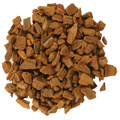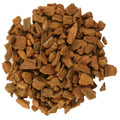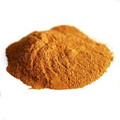 Loading... Please wait...
Loading... Please wait...- Home
- Bulk Herbs
- Herbs (C)
- Cinnamon Sticks
- Home
- Herbs - Organically Grown & Wild Crafted USA
- C-D
- Cinnamon Sticks
- Home
- Herbs from Hawaii
- Cinnamon Sticks
Product Description
Cinnamon Sticks 2 3/4"
Also Known As – Cinnamomum cassia
Origin - Big Island of Hawaii - Wild Crafted
Overview - Cinnamon bark is the dried inner bark from the shoots of the tree from the Lauraceae family. Ceylon (Cinnamomum zeylanicum), Indonesian (Cinnamomum burmanii), and Chinese cassia (Cinnamomum cassia) are the most commonly found species of commerce. In addition to its thousands of culinary uses across a number of various cultures, it has been used for thousands of years as a carminative, astringent, local stimulant, antiseptic, hemostatic, and is widely used in traditional herbal medicine to support healthy digestion.
- Cinnamon has long been used to cure everything from athlete’s foot to indigestion. Early civilizations recognized its ability to stop bacterial growth. The Egyptians used it in embalming. During the Middle Ages, it was mixed with cloves and warm water, and placed in the sick rooms of victims of the Bubonic Plague.
- Recent research indicates that cinnamon can have favorable effects on brain function. Participants in a study chewed cinnamon gum or smelled the sweet spice. Cognitive tests revealed that subjects who used cinnamon had better memory functions and could process information more quickly. Encouraged by these findings, scientists will now conduct studies to see if cinnamon will improve mental skills in the elderly and those prone to anxiety before testing.
- Chinese herbalists tell of older people, in their 70s and 80s, developing a cough accompanied by frequent spitting of whitish phlegm. A helpful remedy, they suggest, is chewing and swallowing a very small pinch of powdered cinnamon. Should be of the highest quality, determined by a bitter-sweet taste. If too bitter and/or not oily, the quality is poor. This remedy can also help people with cold feet and hands, especially at night.
Cinnamon is a dense evergreen tree native to the rain forests of Sri Lanka, Myanmar and the Malabar Coast of India. It also grows well in Hawaii where adult trees have an attractive rounded crown with a mass of small aromatic leaves that provide good shade in addition to flavoring possibilities.
Only one of the Cinnamomum specimens is known as true cinnamon, but it is known by several names; some old, some new. The older names include Ceylon cinnamon or Cinnamomum zeylanicum. The current botanical name for this genus and species is Cinnamomum verum.
True cinnamon is grown commercially in Southeast Asia as well as Brazil, the Caribbean, India and Madagascar. The positive identification of true cinnamon is sometimes confused. Several other members of the Cinnamomumgenus are sold as cinnamon but are referred to in the trade as “cassia” and are actually a different product. Two cassia varieties are native to Arabia, Ethiopia and China and another is native to Northern India. Today, cassia is mainly produced in China, Vietnam and Indonesia.
True cinnamon spice can be identified by its lighter color and the thinner, more crumbly texture of its “sticks” or “quills.” It also has a less sharp, milder and sweeter flavor. Though most of the imported commercial cinnamon sold in the U.S. is actually cassia, we are lucky that there are large wild groves on the Big Island that have true cinnamon growing and available for purchase from sources served by the distributor Adaptations Inc. or you can obtain a permit like we do and ethically harvest up to 100 lbs a year.
A cinnamon tree was first planted in the Hawaiian Islands by William Hillebrand sometime between 1850 and 1870 on his property in Lower Nuuanu Valley on Oahu, which is now part of Foster Botanical Garden.
Cinnamon “best variety” trees arrived here from Jamaica to serve the landscape trade around 1885 and were widely planted.
The true cinnamon tree can grow to more than 30 feet in ideal conditions with a round spreading crown. The leaves are ovate with a pointed tip and are distinguished by a center vein and two others that run parallel. The flowers are very small with cream colored petals and yellow stamens. Once pollinated, they produce a small green fruit that turns dark purple, nearly black as it ripens.
The shoots are usually harvested by cutting them into 4- to 36-inch-long pieces and scraping the external bark off. The cinnamon flavor is strongest in the inner bark or cambium layer of the shoot. It is removed by cutting it with a sharp tool into strips or pounding it to loosen it then removing it into chips and strips. The bark is then dried at a low temperature for several days away from sunlight. The resulting cinnamon sticks are then sold as quills or milled into a fine powder.
Medicinal Uses - There is evidence that Cinnamon Bark extract can help in promoting healthy blood sugar and treating diabetes. Recent U.S.D.A. reports demonstrate that extracts of Cinnamon increase insulin activity, enhancing the breakdown of glucose and improving blood sugar concentrations. A less obvious group who can benefit from this wonderful herbal tincture is women suffering from Polycystic Ovarian Syndrome, or PCOS. In traditional medicine it has been used for digestive ailments such as indigestion, gas and bloating, stomach upset, nausea, diarrhea and painful menstruation. And studies shown that it can lower LDL cholesterol and may be great support for heart health. Cinnamon has a mild anti-clotting effect in the blood, which could be beneficial for some. Cinnamon Bark can also have a mild anti-inflammatory effect and it contains anti-fungal properties that have been shown to have the ability to stop medication-resistant yeast infections. It can wipe out strains of Helcobacter pylori. This is the common cause of ulcers, heart disease, and possibly, some types of cancer. Cinnamon is believed to useful for people who tend to feel hot in their upper body but have cold feet.
Active Constituents - Contains cinnamaldehyde, eugenol, mucilage, tannins, carotenoids, and phenolics.
Other Uses – Quills or sticks are used in spiced punches, teas, cooked fruit, pickling liquids. Ground spice used in sweet baked goods, cooked in fruit, and some meat and fish dishes.
Parts Used – Bark, oil obtained from bark and leaves.
Precautions - Contraindicated in therapeutic doses for pregnant women or individuals with wasting and dryness; especially the essential oil, because the herb is a potential uterine stimulant. Use this herb with care in feverish conditions and bleeding disorders.
Preparation and Dosage - Take a rounded tsp. of cinnamon to a cup of boiling water, stir it and drink while hot. Drink a small portion at a time, 4 to 5 times a day, or drink a cup as needed for griping and pain in the bowels due to gas. Use 1/4 tsp. to a cup of other herbs to flavor them. Put it in with the herbs when the tea is made.
- Steep your favorite herbal tea with a cinnamon stick adds flavor to the tea
- Add one-half teaspoon of cinnamon to unsweetened applesauce
- Add cinnamon to your breakfast cereal or oatmeal
- Sprinkle on toast
- Adding cinnamon to butter or cream cheese
- Sprinkle cinnamon on your morning cup of coffee, cocoa or cappuccino
Disclaimer - These products are not intended to diagnose, treat cure or prevent any disease. Reviews are not intended as a substitute for appropriate medical care or the advice of a physician or another medical professional. Actual results may vary among users. Mountain Maus Remedies LLC makes no warranty or representation, expressed or implied, as to the accuracy or validity of the information contributed by outside product review submissions, and assumes no responsibility or liability regarding the use of such information. The information and statements regarding the dietary supplements have not been evaluated by the Food and Drug Administration. If you have a medical condition or disease, please talk to your health care provider. If you are currently taking a prescription medication, you should work with your health care provider before discontinuing any drug or altering any drug regimen, including augmenting your regimen with any herb or dietary supplements. Do not attempt to self-diagnose any disease or ailment based on the reviews and do not use the information contained herein for diagnosing or treating a health problem or disease. Proper medical care is critical to good health. If you have a health concern or suspect you have an undiagnosed sign or symptom, please consult a physician or health care practitioner.
















